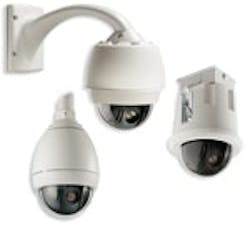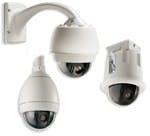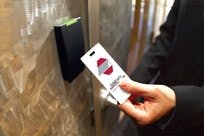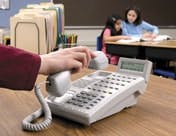Security Technology for Your Educational Facilities
Return to main article - "The Best Defense: Comprehensive School Security"
COURTESY OF BOSCH
Surveillance: One of the most common security technologies, surveillance cameras act as a deterrent while providing a record of events. With closed-circuit television (CCTV), video cameras transmit their signals to a limited set of monitors. Internet protocol (IP) video surveillance systems, unlike analog CCTV systems, can record and archive information digitally. Loren Lloyd, regional sales manager at Torrance, CA-based AMAG Technology Inc., says, "Video is a key component because it goes beyond security; it's a deterrent to misbehavior as well." While there has been some debate about the intrusion of privacy where cameras are concerned, many feel that students are so used to it that it's not even a concern. "Being observed is part of their world," says Chuck Hibbert, president at Indianapolis-based Hibbert Safe School Consulting.
Access Control:
Arguably the most important first step of security systems, controlling who has access (and when) is an obvious need. All doors should be locked afterhours and only one entrance should be open during school hours, provided there is a security guard on duty or an entry vestibule through which visitors have to pass. The technology available for access control runs the gamut, but Lloyd breaks it down into three common "levels."
- Something you have: These systems feature access cards or keys.
- Something you know: You memorize a PIN or code for these systems in addition to using your access card.
- Something you are: Biometric technology isn't widespread in school districts, but we may not be far from the day where fingerprints or eye scans allow entry into an educational facility.
Access control helps protect the building from intruders, but it can also keep track of students and staff for accountability purposes. This feature is called a "mustering capability." According to Lloyd, "If everybody cards in in the morning and an evacuation or crisis occurs ... if they haven't checked into a safety zone, [the system] creates a descending list of who's still inside." This information can aid authorities and help schools keep track of students and staff.
"A visual deterrent beyond video is identification cards," says Lloyd. When each student, teacher, and authorized visitor wears a visible badge or ID card, strangers are easily recognizable. ID badge systems can be inexpensive, with color-coded passes that expire, but there are also sophisticated systems that scan photo IDs, check them against sex-offender databases, and use them to print off professional-looking photo badges in minutes.
There are many areas of communication that are important in school security. Communication between school officials and teachers via pagers is common, as are public address systems and alarms that alert the student body in the event of crisis. Duress alarms let teachers or students silently press a button to notify authorities when they are in dangerous situations. Many school security experts also advocate the creation of a hotline or TIPline (Tell It Please) that students can call to anonymously alert authorities of suspicious activity. A recent development in emergency communication: mass-notification systems, which can send text messages and e-mails, make phone calls, and alert staff through computer programs.
Return to main article - "The Best Defense: Comprehensive School Security"




